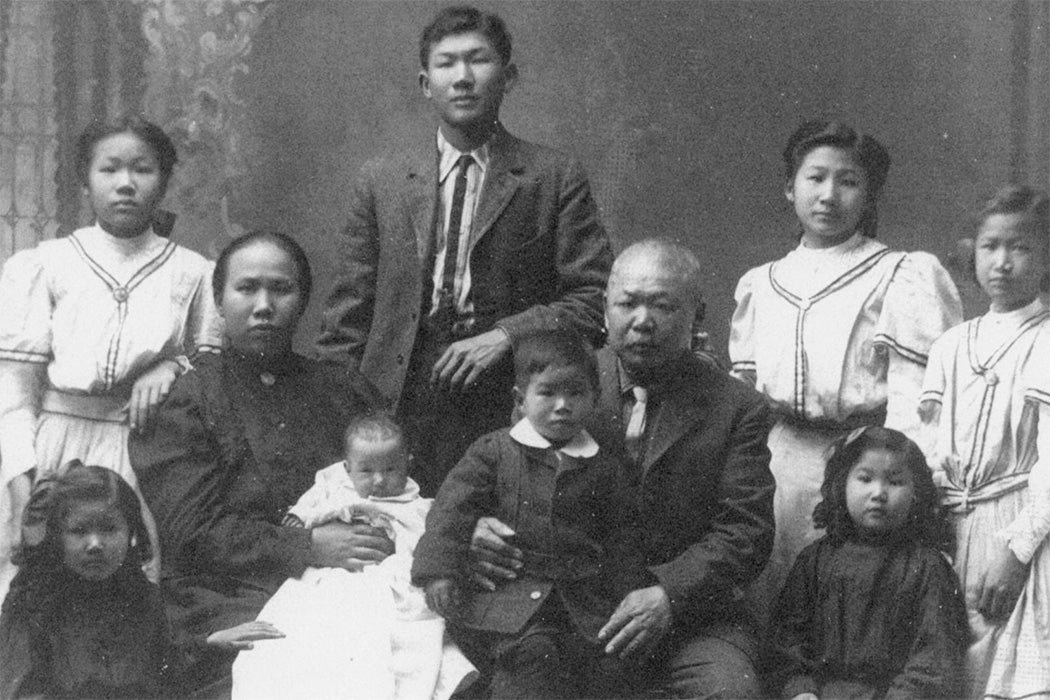Women immigrants were “extremely rare” in early Chinese society, and generally “depended on men for their subsistence,” observes East Asian Studies scholar Li Yang. Through an examination of public records and interviews with surviving family members, Li chronicles the life of one nineteenth-century woman who bucked that stereotype: Lai Ngan, later known as Gertrude Tom, who saw the course of her ordinary life shaped by powerful social and economic forces.
Lai Ngan was born in 1873, probably in the Chinese province of Guangdong, and entered the United States as a child, alongside two opera performers who Li suggests were not her biological parents.
“Trafficking young girls into the United States became a lucrative business during the 1870s,” Li explains, noting that immigration restrictions on Chinese women—who were associated with “criminal or demoralizing purposes”—sparked a trade in under-aged bond servants called maotsai.
Lai Ngan grew up in San Francisco, probably as a maotsai. In her teens, she had an arranged marriage to a much older man, Lee Kwong, a US Civil War veteran who sold cigars in Chinatown. Racist policies would deny Lee Kwong his American Dream. He was stripped off his naturalized citizenship, bestowed in 1874, after a later Supreme Court ruling decreed Chinese immigrants ineligible. Yet, Li writes, “he was fortunate to marry a woman who was both determined and enterprising. So long as she was capable of making a living by working in a shoe factory, opening a boarding house, running grocery stores, rolling cigars, and even sewing, the family never went hungry.”
Lee Kwong and Lai Ngan had been married for only a few years—their eldest child was just six—when Kwong set off for Mexico to prospect for gold in 1893. The family tried to make a living in the mining town of La Colorada in Sonora state, but the “rough-and-tumble atmosphere was no fit place to raise children,” Li reports, pointing to raids, prostitution, poverty, and alcohol use in the town’s bachelor society. As such, they headed in 1896 to the port city of Guaymas, where Lai Ngan found a place for the family in the local economy.
“Although limited in numbers, the Chinese exerted a disproportionally greater influence on the Sonoran economy than the native Mexicans and Yaqui Indians who constituted the great majority of the local population,” says Li. “For instance, Chinese owned at least ten out of thirty-seven Sonoran shoe factories, many of them in and around Guaymas and [state capital] Hermosillo.” Taking advantage of the business niche open to Chinese immigrants, Lai Ngan started out in a Chinese-owned shoe factory, then ran a boarding house, and grocery store.
Disappointingly, Lee Kwong racked up gambling debts—the family was, at one point, on the brink of losing their hard-earned home—while anti-Chinese sentiment was also on the rise. Local newspapers were full of anti-Chinese propaganda, Li notes, describing immigrants as opium traffickers, prostitutes, and diseased.
Thus, Lai Ngan packed up again in 1904. She and her seven children moved first to the border town of Nogales, Sonora, then crossed into the US, where her family became one of the few Chinese families to settle in Nogales, Arizona. When Lai Ngan had her eighth child in 1906, her daughter’s birth certificate listed Lee Kwong’s occupation as “cigar maker,” while Lai Ngan was listed as “housewife.” However, Lai Ngan had always been the family’s main, and often sole, breadwinner, corrects Li. She notes that Lai Ngan had opened yet another store in Nogales. Family lore also holds that “Lai Ngan could roll her own cigarettes, a skill she must have acquired through countless practice” and which Li ties to another source of income—cigar- and cigarette-making.
Weekly Newsletter
Lee Kwong suffered a stroke while on a visit to San Francisco and died in 1913, Lai Ngan having traveled from Nogales to care for him. Three years later, Lai Ngan married Tom Wun, an old friend and fellow cigar maker. Because they wed without the approval of the powerful secret societies or “tongs,” they had to return to Arizona. They lived for a spell in Lai Ngan’s old home of Nogales before moving to 1918 to Tucson—where Lai Ngan would remain, until her death in 1940.
Lai Ngan’s story “draws attention to one immigrant woman’s successful struggle to survive in the American Southwest,” writes Li, and demonstrates “the need for further research to unravel the intricacies of women’s roles in early Chinese immigrant societies.”
Support JSTOR Daily! Join our new membership program on Patreon today.







